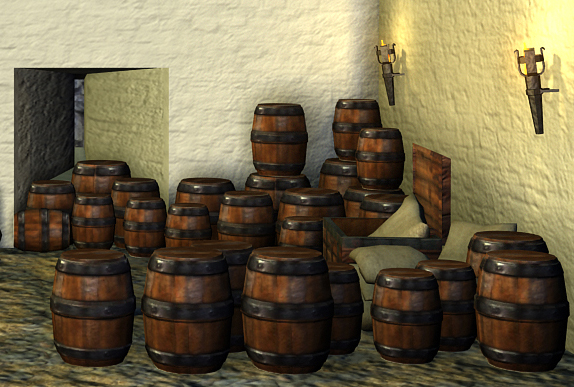Object Descriptions Tower House Ground Floor
Barrels
All homeowners need places to store their goods, including food and drink. The bottom floors of tower houses, often the dampest and coldest areas in the building, were typically used for storage.
Timber was a key export from the Munster plantation, and much of this timber was fashioned into barrel staves for use in the international wine trade. Sir Walter Raleigh gained a monopoly on all such exports out of Munster. His own plantation lands along the Blackwater River were some of the most heavily deforested, for this purpose and others. Timber would also have been used for shipbuilding, house-building and glassmaking. Many trees would also have been consumed in the iron mill industry that Raleigh helped to cultivate.

In 1587, in a brief period of piracy (or opportunism, depending on the legal interpretation), Spenser captained a seized Spanish ship, loaded with many “pipes” (pipe-staves) of wine, and sailed it from the Dingle Peninsula in County Kerry to Cork harbor.
Literary Connections
Spenser was apparently fond of wine, which would have been stored in barrels. The partying poet describes pouring it out “to all that wull” [i.e., “will”] in his wedding poem, “Epithalamion”:
Now al is done; bring home the bride againe,
Bring home the triumph of our victory…
Make feast therefore now all this liue long day,
This day for euer to me holy is,
Poure out the wine without restraint or stay,
Poure not by cups, but by the belly full,
Poure out to all that wull,
And sprinkle all the postes and wals with wine,
That they may sweat, and drunken be withall. (242-3, 248-54)
The party takes place in Spenser’s “home,” or Kilcolman, perhaps in the great hall of the building adjoining the tower house. The great hall was a public space and could accommodate more visitors than the parlors could. A “belly” here refers to the human stomach but also a pouch-like container for wine. The poet, in his metamorphic mind-set, imagines the house itself, like a person, joining in the revelry: the walls themselves “sweat” and are drunk with wine. All Kilcolman rejoices with the bringing home of the bride.
Bibliography:
Nigel Everett, The Woods of Ireland: a history, 700-1800 (Dublin: Four Courts Press, 2014).
Andrew Hadfield, Edmund Spenser: A Life (Oxford: Oxford UP, 2012), 210, 217.
Thomas Herron, “Irish Archaeology and the Poetry of Edmund Spenser: content and context.” Plantation Ireland: Settlement and Material culture, c. 1550-c. 1700 (Dublin: Four Courts Press, 2009), 229-47: 229-32.
Eileen McCracken, The Irish Woods Since Tudor Times (Newton Abbot: David & Charles, 1971).
Kenneth Nicholls, “Woodland cover in pre-modern Ireland.” Gaelic Ireland c.1250-c.1650, land, lordship and settlement. Ed. P.J. Duffy, David Edwards and Elizabeth Fitzpatrick (Dublin: Four Courts Press, 2001), 181-206.
Peter Rieman, “Silvan Matters: Error and Instrumentality in Book I of The Faerie Queene.” Spenser Studies 28 (2013), 119-43.
William J. Smyth, Map-making, Landscapes and Memory: A Geography of Colonial and Early Modern Ireland c. 1530-1750 (South Bend, IN: U of Notre Dame P, 2006): 86-102.
Andrew Zurcher, Spenser’s Legal Language: law and poetry in early modern England (Cambridge: D.S. Brewer, 2007): 111-114.